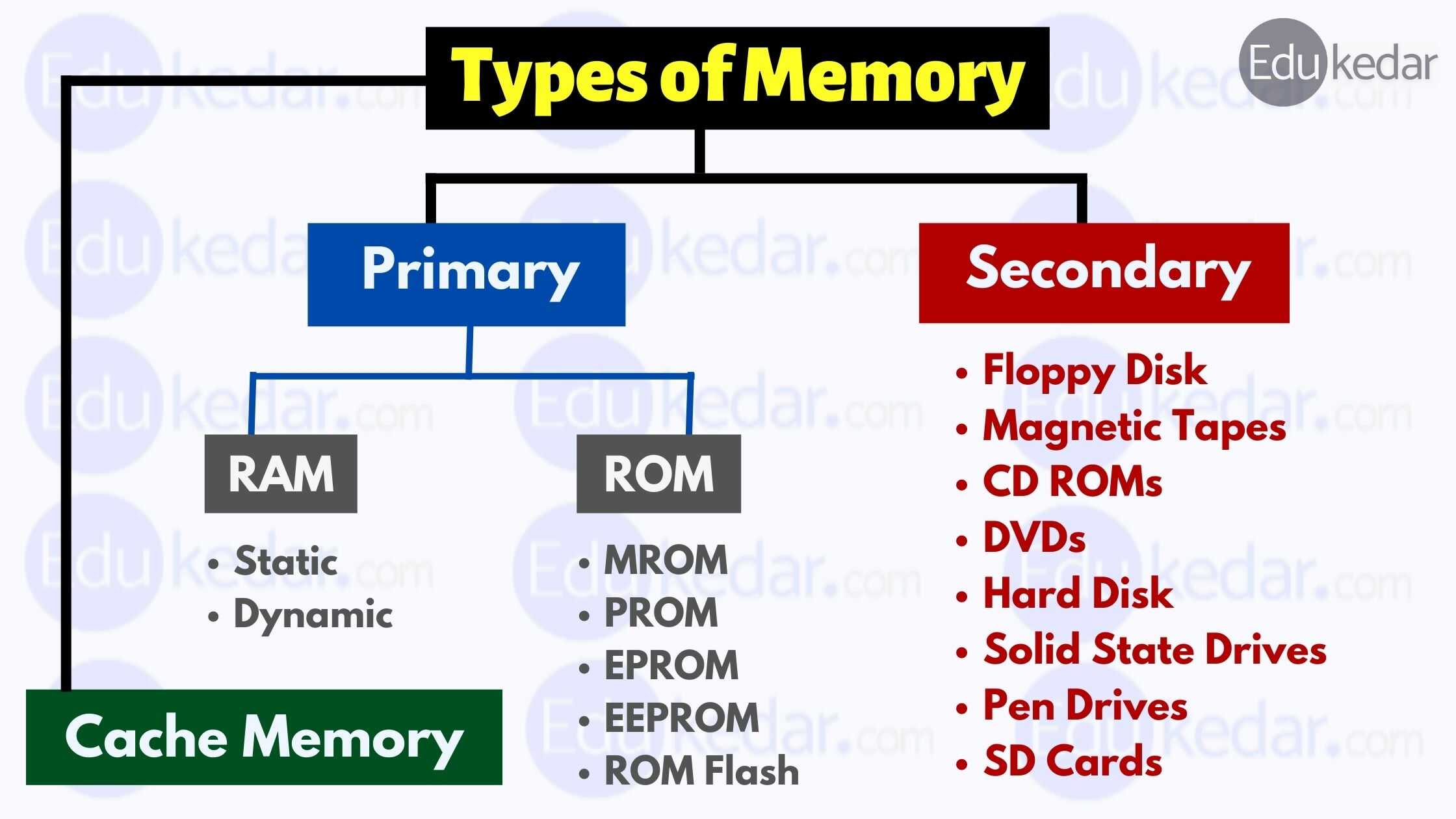Memory is the most important component of any computer system and its normal operation. The memory is divided into categories by the computer system for various functions, and its types of memory in the computer.
Today in this article, we have shared all the types of memory in computers and their characteristics and functions.
❂ Types Of Memory In Computer:
- Primary Memory or Internal Memory (RAM, ROM, Cache)
- Secondary Memory or External Memory (SSD, CD, Floppy-disk, Magnet-tape)
- Cache Memory (It is part of Primary or Internal memory)
The classification of memory is depicted in the diagram below:

The computer system’s main memory, also known as primary memory, communicates directly with the CPU, auxiliary memory, and cache memory.
When the CPU is operating, the main memory is utilized to store programs or data. When a program or piece of data is activated to run, the processor loads instructions or programs from secondary memory into main memory before starting execution.
Because primary memory has a cache or register memory that enables faster response and is placed closer to the CPU, accessing or executing data from it is faster.
The primary memory is volatile, which means that if the data in memory is not stored before a power outage, it will be lost.
It is more expensive than secondary memory, and the capacity of main memory is limited in comparison to secondary memory.
Must Read ➜ Application Layer Protocols
► 1. Primary Memory in Computer
The major types of primary memory (Internal or Main memory) in a computer is split into two sections:
- RAM (Random Access Memory)
- ROM (Read Only Memory)
★ RAM (Random Access Memory):
Random Access Memory (RAM) is a sort of main memory that can be accessed directly by the CPU and is one of the fastest.
It’s the hardware in a computer device that stores data, programs, and program results temporarily.
It’s used to read and write data in memory until the machine is ready to use.
It is volatile, which means that if the computer is shut off or if there is a power outage, the information contained in RAM will be gone. At any time, all data stored in types of memory in computer memory can be read or accessed at random.
Types of RAM Memory in Computer
RAM is divided into two categories:
- Read-only memory
- Write-only memory
DRAM (Dynamic RAM):
DRAM (Dynamic Random-Access Memory) is a form of RAM that is used to store data dynamically. Each cell in DRAM stores one bit of data.
A capacitor and a transistor are the two components of the cell. Because the capacitor and transistor are so small, they must be stored in millions on a single chip.
As a result, a DRAM chip of the same size can store more data than an SRAM chip of the same size. However, because DRAM is volatile, the capacitor must be recharged on a regular basis in order to retain information.
The data stored in memory is lost if the power is turned off.
Characteristics of DRAM
- To keep the data, it must be renewed on a regular basis.
- It’s a little slower than SRAM.
- It can store a lot of information.
- It is made up of a capacitor and a transistor.
- When compared to SRAM, it is less expensive.
- Power usage is reduced.
SRAM (Static RAM):
SRAM (Static Random-Access Memory) is a form of RAM that is used to store static data. It means that data stored in SRAM is active for as long as the computer system is powered up. When there are power outages, however, data in SRAM is lost.
Characteristics of SRAM
- It does not need to be refreshed.
- It outperforms DRAM.
- It’s not cheap.
- Power consumption is high.
- Longer life span
- A big size
- It can be used as cache memory.
Must Read ➜ What is Multiplexing?
★ ROM (Read-Only Memory):
A read-only memory (ROM) is a type of memory or storage medium that is used to store data permanently on a chip. It’s a read-only memory, which means we can only read the information, data, or programs that are stored inside, but we can’t write or modify them.
A ROM is a storage device that holds vital instructions or program data needed to start or boot a computer. It’s a non-volatile memory, which means the data it stores is safe even if the power is turned off or the machine is turned off.
Types of ROM Memory in Computer
Read-Only Memory is divided into five categories:
- MROM
- PROM
- EPROM
- EEPROM
- ROM Flash
1. MROM:
- MROM (Masked Read Only Memory) is a type of memory that is masked and read-only.
- MROM is the oldest type of read-only memory, in which the integrated circuit manufacturer pre-configures the program or data at the time of production.
- As a result, a user cannot alter a program or instruction recorded in the MROM chip.
2. PROM:
- PROM (Programmable Read-Only Memory) is a type of memory that can be programmed.
- It’s a type of digital read-only memory in which the user can only write a single piece of data or program.
- It refers to an empty PROM chip on which the user can only write the desired content or program once with a specific PROM programmer or PROM burner device after that, the data or instruction cannot be modified or erased.
3. EPROM:
EPROM (Erasable and Programmable Read-Only Memory) is a type of read-only memory that can be erased and reprogrammed.
- EPROM memory is a type of read-only memory in which stored data may only be wiped and reprogrammed once.
- It is a non-volatile memory chip that can store data for a minimum of 10 to 20 years when there is no power source.
- If we want to erase any stored data and re-program it in EPROM, we must first put the data via an ultraviolet light for 40 minutes to delete it; then the data is re-created in EPROM.
4. EEPROM:
EEPROM (Electrically Erasable and Programmable Read-Only Memory) is a type of memory that can be erased and reprogrammed.
- The EEROM is an electrically erasable and programmable read-only memory that can be erased and reprogrammed using a high voltage electrical charge.
- It’s also a non-volatile memory, meaning that its contents can’t be erased or lost even if the power is switched off.
- The recorded data in an EEPROM may be erased and reprogrammed up to 10,000 times, and the data is deleted one byte at a time.
5. ROM Flash:
Flash memory is a non-volatile storage memory chip that may be programmed or written in small units known as Blocks or Sectors.
- The contents or data of Flash Memory, which is an EEPROM type of computer memory, cannot be lost when the power supply is switched off.
- It’s also utilized to send data from a computer to a digital device.
Must Read ➜ What is Data Communication?
► 2. Secondary Memory in Computer
Secondary memory is a long-term storage space that can hold a lot of data.
Secondary memory, also known as external memory, refers to the various storage media (hard drives, USB, CDs, flash drives, and DVDs) that can be used to retain computer data and programs for a long time.
It is, however, less expensive and slower than the main memory.
Secondary memory, unlike primary memory, is not accessible directly by the CPU. Instead, secondary memory data is placed into RAM before being transmitted to the CPU to be read and updated.
Examples of Secondary Memory
Magnetic disks, such as hard disks and floppy disks, optical disks, such as CDs and CDROMs, and magnetic tapes are examples of secondary memory devices.
Must Read ➜ Difference between CISC & RISC?
► 3. Cache Memory in Computer
Cache Memory is a chip-based computer memory that is located between the CPU and the main memory.
- It is quicker, high-performance, and temporarily designed to boost the CPU’s performance.
- It contains all of the data and instructions that computer CPUs frequently use.
- It also speeds up data retrieval from the main memory.
- It is faster than the main memory, and because it is so close to the CPU chip, it is frequently referred to as CPU.
The tiers of cache memory are as follows.
Memory Address Register (MAR)
The register memory is a temporary storage place for data and instructions to be stored and transferred to a computer.
- It is the computer’s smallest and fastest.
- It is a type of computer memory that is stored in the CPU as registers.
- The register memory is available in 16, 32, and 64-bit sizes.
It temporarily saves data instructions and the memory address that is utilized repeatedly to enable faster CPU response.





